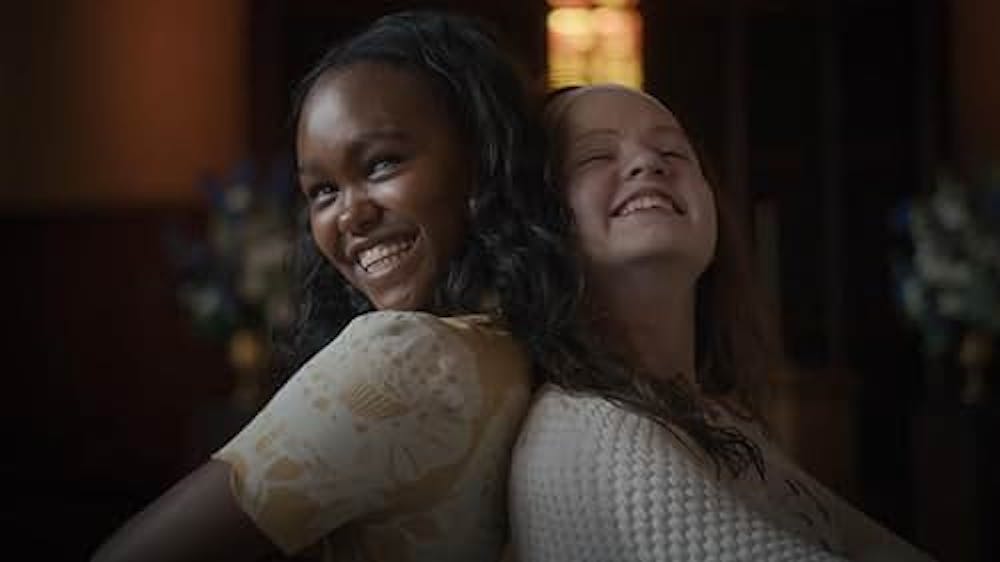Ellen Burstyn, reprising her role as Chris MacNeil (the doubtful mother of the original Exorcist film), comforts Victor (Leslie Odom Jr.), the father of our sequel’s possessed preteen girl, saying, “You have to bring everyone together. That’s what will make this thing work.”
After the credits begin to roll, it becomes apparent that “this” is better understood as Blumhouse’s forthcoming Exorcist trilogy, not the final act of exorcism.
“The Exorcist: Believer” is slated as the first of three Exorcist films, led by the creative duo of Danny McBride and David Gordon Green. This isn’t McBride and Green’s first attempt at a revival of a classic horror franchise — they brought back Michael Myers and the Halloween franchise in three films from 2018 to 2022 to decreasing success. Given this history and the rapid, messy wrap-up of the story in “The Exorcist: Believer,” it’s easy to be cynical about Burstyn’s aforementioned team-up.
The film begins with a flashback to a trip to Haiti by Victor and his pregnant wife, Sorenne (Tracey Graves). She and her daughter are blessed by a voodoo practitioner prior to a tacky usage of the 2010 Haiti earthquake to catalyze the film’s story and conflict. Sorenne is mortally injured during the earthquake, and Victor is faced with the choice of saving his unborn daughter or his wife. Before we see his decision, the film returns to the present day.
We see Victor as a single father with a healthy relationship with his daughter, Angela (Lidya Jewett). Angela has a religious friend, Katherine (Olivia O’Neill), who helps her attempt to conjure the spirit of her mother. As creators primarily known for their comedic chops, the first act and these relationships are where the film is the strongest. In their first (and only) scene together pre-possession, Victor and Angela are seen playfully teasing each other over her new-found veganism and participating in a game of hide-and-seek that seemingly happened a hundred times before.
Victor’s character is fully fleshed-out as both a father and individual, and the two girls’ relationship feels genuine. Here, McBride and Green are working with characters and ideas of their own creation. As the spirits started to possess the girls, McBride and Green are enveloped by the imprecise definition of what an Exorcist movie is or should be.
While dealing with their daughters’ deteriorating states and their understanding of what exactly is occurring, the central thematic conflict is established between Katherine’s parents and Victor: reconciling the mystical in a secular world. Namely, how can an objective, severe evil be triumphed by anything except complete faith in a divine good?
Katherine’s parents, Miranda and Tony (played by Miranda Nettles and Norbert Leo Butz, respectively), are staunch evangelical Christians, while Victor is distinctly faithless. Victor is stubbornly convinced of the spiritual nature of his daughter’s ailments through a conversation with Chris MacNeil and her eventual attempt to help exorcize the spirits afflicting the two girls. Before her daughter’s possession, MacNeil shared his doubt. Yet, the overwhelming fact of the spiritual nature of her daughter’s affliction overpowered her doubt. Despite this powerful thematic parallel, she is quickly removed from the main conflict and confined to a hospital bed for the final act of the film.
This is where we first see McBride and Green’s struggle to overcome the source material. Trying to balance scale and story, they seem to lose their intention in delivering fan service and nostalgia. Paradoxically, this leads to the film falling short of the impact of the original “Exorcist.” At its core, it was a movie about a mother and daughter. Were it not for the unnecessary addition of a second possession and five-too-many religious figures, the same could have been said about “The Exorcist: Believer.”
The final act consists of an Avengers-style team of eight parents and religious figures and the titular exorcism. In the same way a CGI-filled final battle of a Marvel movie appears as visual noise, the extra characters and forms of faith distract from the relationships viewers actually care about. A frantic camera cuts from one religious figure to another or from flickering light to shattering glass, yet all we care about are the sincere eyes of Victor clawing their way back into his daughter’s soul.
Each form of faith (the classic Catholic priest, a pentecostal minister, and a rootwork healer) plays an important role in the exorcism. “The Exorcist: Believer” neither looks down at nor look up to any type of faith. While the original is oft-referenced in the film, it is not revered. It’s this blasé treatment of both the divine and the foundations of the Exorcist story that create a film that leads nowhere.
“The Exorcist: Believer” feels like a movie that had a coherent vision, but was muddled throughout the production process and in the editing room. McBride and Green obviously have a reverence for the classic horror movies that shaped their youth and a desire to retool them for a new generation, but the structure of the classics binds their ability to do so. “The Exorcist: Believer” asks interesting questions, but it doesn’t have the fortitude to answer them.
Get The Chronicle straight to your inbox
Sign up for our weekly newsletter. Cancel at any time.
Kadin Purath is a Trinity junior and a culture editor for Recess.

